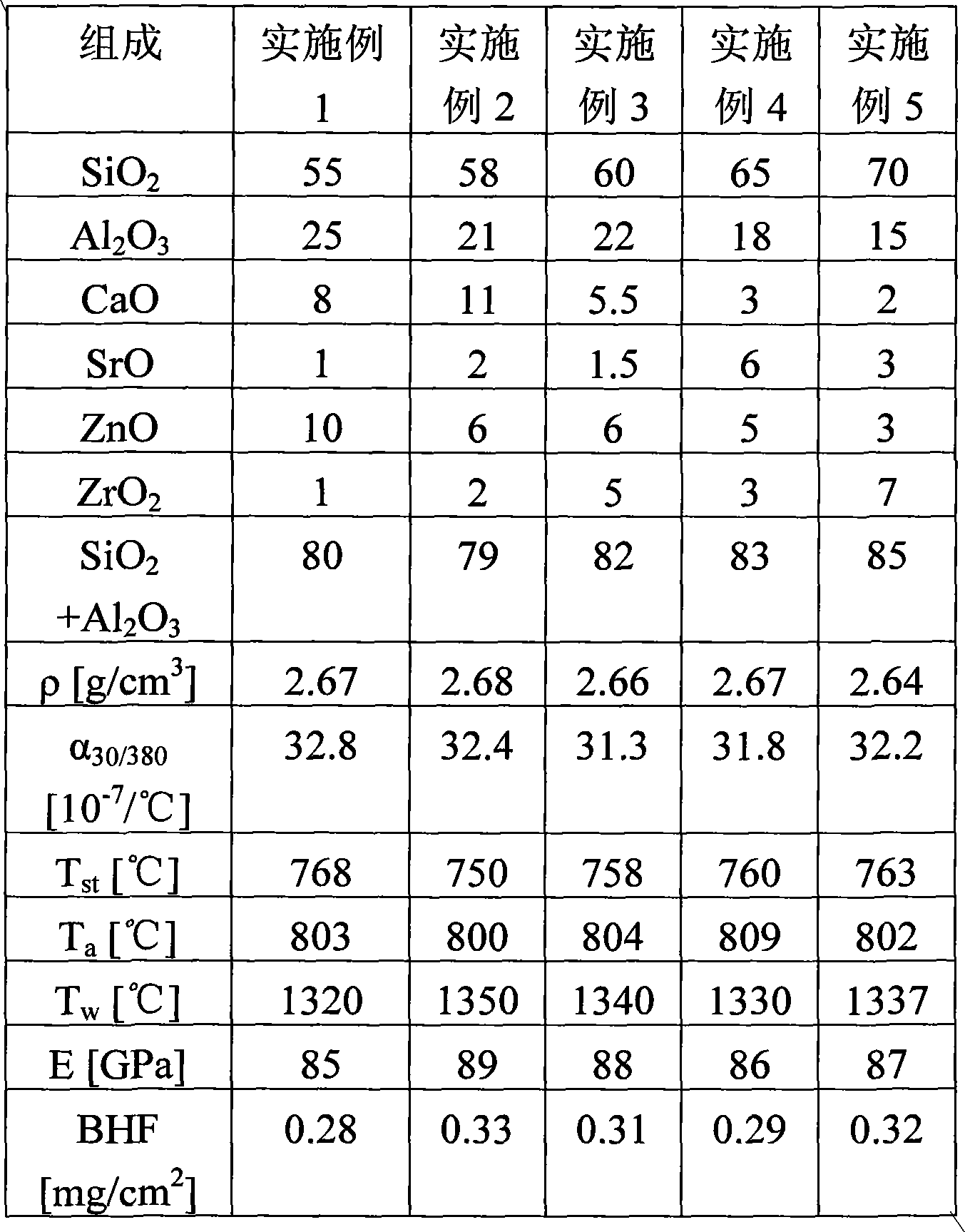Alkali-free alumina silicate glass with high strain point
A silicate glass, high-strain technology, used in the field of substrate glass for flat panel displays, alkali-free aluminosilicate glass
- Summary
- Abstract
- Description
- Claims
- Application Information
AI Technical Summary
Problems solved by technology
Method used
Image
Examples
Embodiment 1
[0034] First, select the raw material according to the glass composition of Example 1 in Table 1, the raw material requirements, quartz sand (the 150 μm sieve is less than 1%, the 45 μm sieve is less than 30%, Fe 2 o 3 content less than 0.01wt%), aluminum hydroxide or aluminum oxide (average particle size 50 μm), calcium carbonate (average particle size 250 μm), strontium nitrate or strontium carbonate (average particle size 50 μm), zinc oxide (average particle size 60 μm sieve 1% or less), zirconium silicate or zirconium dioxide (the average particle size of 45 μm is 1% or less), and the alkali metal oxide content in the raw material is less than 0.1%. And the Fe in the glass raw material 2 o 3 Strictly controlled, the finished glass Fe 2 o 3 The content is less than 150PPm. The clarifying agent is tin oxide, and its ingredients meet the chemical composition of the glass in Table 1, and then it is melted at 1570° C. for 24 hours using a platinum crucible. After melting,...
Embodiment 2
[0036] The actual composition of the glass refers to Example 2 in Table 1. The same raw materials and raw material requirements as in Example 1 are used, and the same melting process system and test conditions are adopted. Table 1 shows the basic properties of the samples. (1) The density is 2.68g / cm 3 ; (2) The average linear expansion coefficient of 30-380°C is 32.4×10 -7 / °C; (3) Strain point T st 750°C; (4) Annealing point T a 800°C; (5) Working point T w (6) Elastic modulus is 89GPa; (7) Hydrofluoric acid buffer corrosion resistance 0.33mg / cm 2 .
Embodiment 3
[0038] Refer to Example 3 in Table 1 for the actual composition of the glass, use the same raw materials and raw material requirements as in Example 1, and adopt the same melting process system and test conditions. Table 1 shows the basic properties of the samples. (1) The density is 2.66g / cm 3 ; (2) The average linear expansion coefficient of 30-380°C is 31.3×10 -7 / °C; (3) Strain point T st is 758°C; (4) annealing point T a is 804°C; (5) Working point T w (6) Elastic modulus is 88GPa; (7) Hydrofluoric acid buffer corrosion resistance 0.31mg / cm 2 .
PUM
| Property | Measurement | Unit |
|---|---|---|
| density | aaaaa | aaaaa |
| strain point | aaaaa | aaaaa |
| elastic modulus | aaaaa | aaaaa |
Abstract
Description
Claims
Application Information
 Login to View More
Login to View More - R&D
- Intellectual Property
- Life Sciences
- Materials
- Tech Scout
- Unparalleled Data Quality
- Higher Quality Content
- 60% Fewer Hallucinations
Browse by: Latest US Patents, China's latest patents, Technical Efficacy Thesaurus, Application Domain, Technology Topic, Popular Technical Reports.
© 2025 PatSnap. All rights reserved.Legal|Privacy policy|Modern Slavery Act Transparency Statement|Sitemap|About US| Contact US: help@patsnap.com

